Springs
HOLY MOUNTAIN TRAILS: A SHORT HISTORY OF MT. ATHOS AND GRIGORIOU MONASTERY
In the Garden of Our Lady
Assumption of the Holy Virgin, as well as all other holidays dedicated to this protector of the Holy Mountain, is celebrated here with special joy. We witnessed this year’s celebrations of the Holy Virgin and experienced that again. It was a good opportunity to once again, together, remind ourselves of the history of this place and to visit the renowned monastery founded in the 14th century by St. Gregory the Silent, of Serbian origin
Text and photographs: Mišo Vujović
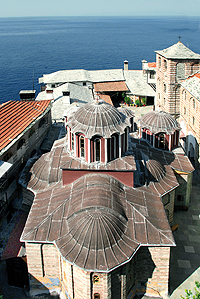 At the crack of dawn on the day of the Assumption of the Holy Virgin in Ouranopolis, the last lay station on the road to the Holy Mountain, it was crowded like in a beehive. Sleepy river of pilgrims carrying heavy gifts for Holy Mountain monasteries was flowing down and disappearing in the hull of the first ship sailing that morning, ”Agia Ana” (”Saint Anna”). At the crack of dawn on the day of the Assumption of the Holy Virgin in Ouranopolis, the last lay station on the road to the Holy Mountain, it was crowded like in a beehive. Sleepy river of pilgrims carrying heavy gifts for Holy Mountain monasteries was flowing down and disappearing in the hull of the first ship sailing that morning, ”Agia Ana” (”Saint Anna”).
On crowded terraces of nearby restaurants and cafes, people were drinking beverages for refreshments and to wake up. In exchange for a baksheesh ”na sevte” (first guests), an elderly hostess thanked with a full basket of cookies.
Some of them, still standing, and before entering the fasting throne of the ”Queen of the Heavens”, were eating the last bites of their non-vegetarian morning meals in a hurry. Several harbor cats curled up around their feet, and a flock of snow-white seagulls ”greberaši”, a part of feathery squadron that followed every ship toward the Holy Mountain, waited in the ambush for the ship to set sail and for their first ration.
”Grigora, Grigora”, yelled chronically nervous sailors, hurrying up the sleepy travelers stuck in the narrow aisle that leads to the cabins and upper deck.
”Greeks, temperament and unorganized as they are, are always protected by God, because they have never renounced him”, remarks Zoran, a ”Holy Mountainer” outside the Holy Mountain, whose barefaced heir Pavle is slowly starting to follow his father’s footsteps.
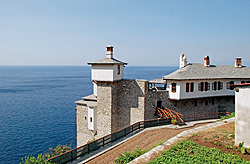 At the freight part of the ship, like in a tin can, almost leaning on one another, monastery jeeps and pick-up trucks are parked, loaded with various necessities. At the freight part of the ship, like in a tin can, almost leaning on one another, monastery jeeps and pick-up trucks are parked, loaded with various necessities.
The Assumption of the Holy Virgin, just like other holidays dedicated to this protector of the Holy Mountain, is celebrated here with special joy.
Most of the travelers on the ship are headed for the Saint Day of Iviron Monastery. The holiday in Iviron, one of five biggest monasteries in the monks’ state, was attended by almost two thousand guests. Delegation from the Serbian Monastery Hilandar was headed by hieromonk Marko, with a priest and guests from Montenegro.
While the sun is shyly getting up from behind Athos, about 2,033 meters high, the ship, cutting through blue-green surface, is rushing toward the coast of the only state in the world where there is no mundane birth giving, but from where the prayers full of life have been ascending toward heavens for almost 1,500 years.
In the past few years, the Holy Mountain has also been a big construction site. In addition to monastery complexes, some of which, like Great Lavra, have stepped into the second millennium, smaller monk communities are also being restored – the so-called ”skete”, ports are being made, roads...
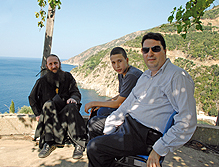 At the jetty of St. Pantelejmon, freight ship ”Rafael” is docked. It is used to transport huge quantities of construction material for a grandiose monastery complex, now washed and empowered with material and spiritual reconstruction, just like its parent state, Russia, the power of which is still reflected, as was before, in this pearl on the very coast of the Holy Mountain gulf. When the reconstruction is finished, guest residencies will be able to accommodate over 2.000 visitors. At the jetty of St. Pantelejmon, freight ship ”Rafael” is docked. It is used to transport huge quantities of construction material for a grandiose monastery complex, now washed and empowered with material and spiritual reconstruction, just like its parent state, Russia, the power of which is still reflected, as was before, in this pearl on the very coast of the Holy Mountain gulf. When the reconstruction is finished, guest residencies will be able to accommodate over 2.000 visitors.
Harmonious chanting of the brotherhood of Simonopetra Monastery, built on the top of the cliff above the see, is coming out of the ship’s loudspeaker. Only here, on Mount Athos, the prayers are constantly, as a hymn to Christ and eternity for over one thousand years, ascending toward heavens.
Prayer is a tool, bed, food, word, life, joy, essence, victory, meaning, salvation eternity... It was used by friars to defeat numerous conquerors, from the pirates of the sea and road bandits to great empires that occupied the monks’ empire for shorter or longer periods. Even most of the occupiers of the Holy Mountain respected the autonomy of philanthropy, godliness and absence of passion of Athos devotees.
ORGANIZED SINCE THE 9TH CENTURY
Walls with high towers, similar to medieval bastions, serve as a testimony of those turbulent times, and the accounts tell that monks did not defend themselves only with Holy Scriptures and prayers. Rusted maces that hang at the entrance door, fortified with iron, leading to the Holy Land Monasteries, still stand as reminder of evil times, but also as a warning to ill-intentioned and uninvited guests.
Although historical accounts say that as far back as in the 7th century there used to be smaller communities of monks, the so-called skete, the first forms of organized monastic life are dated from the 9th and 10th century.
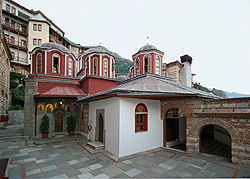 Synod in Constantinople in 843, at the time of Empress Theodora, assembled on the occasion of reinstating the use of icons, was also attended by Athos monks. Athos was clearly a refuge for exiled monks during the period of iconoclasm, in the 8th century. Confirmation that there was organized monastic life in the 9th century can be found in the charter of Emperor Leo VI, created in 893, in which the ancient seat of the so-called old men is mentioned. It is assumed that the ancient cathedra of elders, also mentioned in some other sources, was placed in the first lavras, the most important of which are Kliment’s and the one in Zig, in the northern part of the peninsula. Many legends say that, prior to the arrival of Christian devotees to the Athos peninsula, there used to be important pagan (polytheist) shrines there, but there is no historical source from the 7th century until today saying that lay priests used to inhabit this area. The establishment of monastery life in the 9th century is accounted for in the mission of three Holy Mountain saints, St. Petar Atonski, St. Evtimije Novi and his pupil, St. Jovan Kolov. Professor Athanasius Angelopulos says that the three saints encountered an organized monastic life in the northern part of the peninsula. Synod in Constantinople in 843, at the time of Empress Theodora, assembled on the occasion of reinstating the use of icons, was also attended by Athos monks. Athos was clearly a refuge for exiled monks during the period of iconoclasm, in the 8th century. Confirmation that there was organized monastic life in the 9th century can be found in the charter of Emperor Leo VI, created in 893, in which the ancient seat of the so-called old men is mentioned. It is assumed that the ancient cathedra of elders, also mentioned in some other sources, was placed in the first lavras, the most important of which are Kliment’s and the one in Zig, in the northern part of the peninsula. Many legends say that, prior to the arrival of Christian devotees to the Athos peninsula, there used to be important pagan (polytheist) shrines there, but there is no historical source from the 7th century until today saying that lay priests used to inhabit this area. The establishment of monastery life in the 9th century is accounted for in the mission of three Holy Mountain saints, St. Petar Atonski, St. Evtimije Novi and his pupil, St. Jovan Kolov. Professor Athanasius Angelopulos says that the three saints encountered an organized monastic life in the northern part of the peninsula.
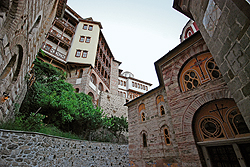 Out of three of them, the first (Petar) came to the HolyMountain around 840, the second one (Evtimije) established lavra in 860, and the third one (Jovan) established the monastery in Ierisos, the borders of which stretch all the way to Zig. Three of them represent three different ascetic tendencies: the first one is the ”eromitski” (desert) type, namely the cave (speleological) type, the second one is lavra or Scythianascetism, the third one is ”kinovijski” (community life) system. Out of three of them, the first (Petar) came to the HolyMountain around 840, the second one (Evtimije) established lavra in 860, and the third one (Jovan) established the monastery in Ierisos, the borders of which stretch all the way to Zig. Three of them represent three different ascetic tendencies: the first one is the ”eromitski” (desert) type, namely the cave (speleological) type, the second one is lavra or Scythianascetism, the third one is ”kinovijski” (community life) system.
Creation of the final appearance of the Holy Mountain community begins in the mid 10th century, with the establishment of Great Lavra Monastery. While building its foundation, its founder St. Athanasius the Great, with the support of the pious general Nikephoros Phokas, who later became a monk committed to fasting and prayers, begins reform of monkhood on the Holy Mountain.
THE BEGINNINGS OF COMMUNITY LIFE
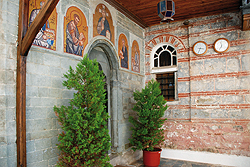 The founding of the monastery was preceded by turbulent historical events consisting of conflicts between the Byzantine and Arabian pirates who, between 824 and 960, reigned over Corfu and the entire Mediterranean. In 904, the Saracen pirates even occupied and looted Thessaloniki. Maritime traffic almost completely halted, trade was interrupted, coastal population was moving inland. Byzantine was repeatedly defeated, and in the last maritime battle in 949 it was impossible to count the dead, while Crete thrived in wealth and white slaves. In that 960, Joseph Bringas placed at the head of the army Nikephoros Phokas, a nobleman from the Middle East. After a difficult siege that lasted the entire winter, in the spring of 961 he conquered the capital of Crete, and completely destroyed the pirates’ nest Handaka (today’s Iraklion). The founding of the monastery was preceded by turbulent historical events consisting of conflicts between the Byzantine and Arabian pirates who, between 824 and 960, reigned over Corfu and the entire Mediterranean. In 904, the Saracen pirates even occupied and looted Thessaloniki. Maritime traffic almost completely halted, trade was interrupted, coastal population was moving inland. Byzantine was repeatedly defeated, and in the last maritime battle in 949 it was impossible to count the dead, while Crete thrived in wealth and white slaves. In that 960, Joseph Bringas placed at the head of the army Nikephoros Phokas, a nobleman from the Middle East. After a difficult siege that lasted the entire winter, in the spring of 961 he conquered the capital of Crete, and completely destroyed the pirates’ nest Handaka (today’s Iraklion).
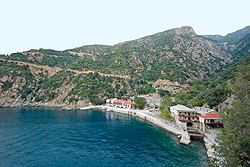 ”In his campaign on Crete, Nikephoros Phokas had next to himself holy Athanasius the Athonite... Nikephoros Phokas ascribed his success on Crete to God’s will and prayers of St. Athanasius, who received big quantities of pirate treasures to build a monastery, reiterating his promise that they would live as monks together”, says Athanasius Angelopulos in the book Holy Mountain Community of Monks. ”In his campaign on Crete, Nikephoros Phokas had next to himself holy Athanasius the Athonite... Nikephoros Phokas ascribed his success on Crete to God’s will and prayers of St. Athanasius, who received big quantities of pirate treasures to build a monastery, reiterating his promise that they would live as monks together”, says Athanasius Angelopulos in the book Holy Mountain Community of Monks.
Two years later, on March 15th, 963, after the death of Emperor Romanos II, Byzantine was ruled by lawlessness and terror of Roman’s officer, eunuch Joseph Bringas, and as the result of this, the army proclaimed Nikephoros Phokas a king. On August 14th, the new emperor-warrior leading his legions enters Constantinople, and three days later he was crowned in Hagia Sophia as a Byzantine emperor.
Athanasius then stopped building the monastery, asking himself what is the purpose of building a monastery for two people, if one of them desired vane mundane glory. However, emperor’s mercy and generous gifts for the continuation of the construction made the great anchorite to continue his mundane, but also heavenly construction work. At the same time, the emperor continued to live ascetic life in his palace, sleeping on the floor covered with a frock that belonged to his uncle Mihailo.
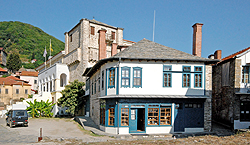 The construction of big monastery disturbed the HolyMountainanchorites and ascetics. Big monastery community consisting of 80 monk, headed by St. Athanasius, profoundly changed the former way of ascetic life, which created an opposition to this reformer-devotee among the members of the old ways of life. The idea of Athanasius the Athonite was not to earn salvation through solitude, but to establish a community which would spread the eternal evangelic light on all people in this ”sad mundane anthill”. Since they knew that power in Constantinople was in the hands of his friend Nikephoros Phokas, and that the reputation of the abbot of the Great Lavra is overshadowing the Protos of the Holy Mountain, those who were opposing change were silently waiting until the grave murder of the emperor-hermit in the night between December 10th and 11th, 969, when John Tzimiskes took over the throne. After a complaint about the new way of life, which was handed out to him by a delegation of Athonites headed by the Protos, he sends Eftimie, the abbot of a studite monastery from Constantinople, ”to bring peace to the opposing parties and regulate the monastery life on the Holy Mountain”. The construction of big monastery disturbed the HolyMountainanchorites and ascetics. Big monastery community consisting of 80 monk, headed by St. Athanasius, profoundly changed the former way of ascetic life, which created an opposition to this reformer-devotee among the members of the old ways of life. The idea of Athanasius the Athonite was not to earn salvation through solitude, but to establish a community which would spread the eternal evangelic light on all people in this ”sad mundane anthill”. Since they knew that power in Constantinople was in the hands of his friend Nikephoros Phokas, and that the reputation of the abbot of the Great Lavra is overshadowing the Protos of the Holy Mountain, those who were opposing change were silently waiting until the grave murder of the emperor-hermit in the night between December 10th and 11th, 969, when John Tzimiskes took over the throne. After a complaint about the new way of life, which was handed out to him by a delegation of Athonites headed by the Protos, he sends Eftimie, the abbot of a studite monastery from Constantinople, ”to bring peace to the opposing parties and regulate the monastery life on the Holy Mountain”.
That is how in 972 the firstHoly Mountain Tipik, or statute, was created, called ”Tragos” (”Goat”), because it was written on the pieces of goat hide. It was signed by 56 gerondes (elders), and personally endorsed by John Tzimiskes with his red imperial signature, preserved until today.
THROUGH TURBULENT TIMES
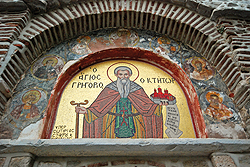 The first tipik fully legalized the concept of community life of Saint Athanasius the Athonite, and his popularity among monks attracted to the Holy Mountain a large number of new novices and monks. In the second half of the 190th century, in addition to the Great Lavra, seven other new monasteries were founded on the Holy Mountain: Amalfi (of which a tower remains in the area of Morfin), Iviron, Zographou, Xeropotamou (now Saint Paul’s Monastery), Vatopedi and Xenophontos. About 3,000 monks lived in them. The first tipik fully legalized the concept of community life of Saint Athanasius the Athonite, and his popularity among monks attracted to the Holy Mountain a large number of new novices and monks. In the second half of the 190th century, in addition to the Great Lavra, seven other new monasteries were founded on the Holy Mountain: Amalfi (of which a tower remains in the area of Morfin), Iviron, Zographou, Xeropotamou (now Saint Paul’s Monastery), Vatopedi and Xenophontos. About 3,000 monks lived in them.
Expansion of monastic life on the Holy Mountain continues in the 11th century, through the establishment of about 180 monasteries, among which are Esphigmenou, Dochiariou, Karakalou, Hilandar, Stavronikita, Philotheou and Panteleimon. In the 12th century, Serbs rebuilt the abandoned Hilandarion, and Russians rebuilt the Monastery of Saint Panteleimon. In the early 13th century, about 300 bigger and smaller monasteries where operational. This century also brings great unrest, destructions lootings, devastation of the Holy Mountain, which changes its lords frequently, from Francs, Normans, Catalonians, Turks, to pirates.
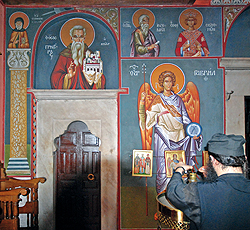 In the first decade of the 14th century there was a great destruction and a big number of monks were killed in the attack of Catalonian pirates, who mercilessly spread fire, killed and looted. The extent of this crime was so great that Theodore Magister wrote in his epistle: In the first decade of the 14th century there was a great destruction and a big number of monks were killed in the attack of Catalonian pirates, who mercilessly spread fire, killed and looted. The extent of this crime was so great that Theodore Magister wrote in his epistle:
”After losing almost all of its monks, Athos is lifting its sorrow toward heavens... Suddenly and immediately, monasteries, cells, churches and cottages turned desolate, those which led to salvation with wealth collected in them, and those who lived in them were slaughtered, like priestly sacrifices.”
Already in the mid 15th century the monastery life resurrects again. On the foundations of the destroyed churches, the builders make new and more grandiose ones, the abandoned temples are imbued with power of revival and life. Simultaneously with the works on reconstruction, spiritual reforms also take place, leading to even more advanced movements, like isihastic movement. The Holy Mountain monks are recognized and respected in the entire Christian Orthodox world.
AFTER GREGORY THE SILENT
From Dafni, the main sea port of the Holy Mountain, to Grigoriou Monastery, our first prayer station, there is another ten minutes of sailing. The ship ”Hagia Anna” continues, half empty, its route to the skete with the same name, until where there are another two stops Dionysiou and St. Paul.
 From the new, beautifully arranged port, up the shallow stone stairs, over which two concrete strips were laid for freight vehicles, we arrive to the plateau above the sea where Grigoriou Monastery is located. Build of white stone, on the rock above the foaming waves. It was founded in early 14th century by Saint Gregory, of Serbian origin, who gathered a large number of monks from the Slavic world. Today this brotherhood consists of 80 devotees, among which is father Siluan, a Serb from Kosovo, a host ho welcomes his guests with kindness and smile of a monk. He has been in the service of eternity and salvation in Grigoriou Monastery for 12 years. From the new, beautifully arranged port, up the shallow stone stairs, over which two concrete strips were laid for freight vehicles, we arrive to the plateau above the sea where Grigoriou Monastery is located. Build of white stone, on the rock above the foaming waves. It was founded in early 14th century by Saint Gregory, of Serbian origin, who gathered a large number of monks from the Slavic world. Today this brotherhood consists of 80 devotees, among which is father Siluan, a Serb from Kosovo, a host ho welcomes his guests with kindness and smile of a monk. He has been in the service of eternity and salvation in Grigoriou Monastery for 12 years.
Gregory Isihast, better known as Gregory the Silent, was born in late 13th or early 14th century. He was a pupil of St. Gregory Sinait and St. Romil of Ravanica, with whom he moved to live in a skete called Magula, across from Philotheou Monastery. In the 14th century, Mt. Athos monasteries were unselfishly supported by Serbian despot Jovan Uglješa Mrnjavčević, who is considered to be the second founder by numerous St. Athos monasteries, says St. Justin Ćelijski. Merciful Jovan Uglješa then became a benefactor and founder of monasteries Vatopedi, Hilandar, Simonopetra, Saint Paul, and even St. Nicholas Monastery, called Grigoriou, the construction of which was started by great Saint Gregory Sinait, and was finally finished by St. Gregory the Silent.
 In the visit to father Siluan, we meet a seventeen year old Stefan from Zemun, a student of a high school of music. Stefan serves us coffee and ratluk, water and indispensable St. Athos pomace brandy – tsipouro. After refreshment, father Siluan leads us to a wooden patio over the sea. Below our feet waves nosily break over the cliff. The view slides over a glassy blue surface that fuses with the indefinite whiteness on the horizon. On the other side, next to the monastery temple St. Nicholas the Miracle-Maker and stairs on which a ramp for people with disabilities was built, we walk down the narrow path to the elevator. It takes us to a flattened plateau from where the agricultural cooperative begins. In the visit to father Siluan, we meet a seventeen year old Stefan from Zemun, a student of a high school of music. Stefan serves us coffee and ratluk, water and indispensable St. Athos pomace brandy – tsipouro. After refreshment, father Siluan leads us to a wooden patio over the sea. Below our feet waves nosily break over the cliff. The view slides over a glassy blue surface that fuses with the indefinite whiteness on the horizon. On the other side, next to the monastery temple St. Nicholas the Miracle-Maker and stairs on which a ramp for people with disabilities was built, we walk down the narrow path to the elevator. It takes us to a flattened plateau from where the agricultural cooperative begins.
It is fascinating to look at that cultivated and sophisticated nature, gardens in greenhouses, terraces cut into the hill. Water comes from a nearby spring and in sufficient quantity, but diligent monks also provided tanks and a system of economical irrigation. There is almost no variety that could not be grown in the gardens. Zoran is picking basil, Siluan offers us figs and grapes. Pavle is making photos of the dome and roofs of monastery buildings. Monks object to the presence of camera lens without abbot’s blessing. For them, civilization has been in the past for a long time, they are dead for the world they came from.
BLESSING IS FLICKERING IN THE FLAME
 Grigoriou Monastery is truly a well organized enterprise. With a technologically perfect agricultural cooperative, a small marina and a big port, monks have several workshops, dental office, operating room for minor interventions. Of course, they also have qualified and trained staff to provide services in these facilities. The entire monastery complex is connected with radio connection, even roof windows on church domes (left because of humidity and ventilation) are opened and closed with remote control. Grigoriou Monastery is truly a well organized enterprise. With a technologically perfect agricultural cooperative, a small marina and a big port, monks have several workshops, dental office, operating room for minor interventions. Of course, they also have qualified and trained staff to provide services in these facilities. The entire monastery complex is connected with radio connection, even roof windows on church domes (left because of humidity and ventilation) are opened and closed with remote control.
And while we are marveling at the harmony with which a human mind managed to bring together things from different eras, father Siluan humbly talks about challenges that a contemporary man is going through, filled with joy because an increasing number of young people in Serbia are returning to faith and the old way of life.
”Greeks are traditionally religious, but fewer and fewer young people are going to church. Majority of people here are well over their forties. And in our country temples are full of young and educated people”, he tells us while we are resting under a grape vine, on the elevation above the monastery, from where, over stone plates covering roofs of residences, there is a great view on the fused blueness of the sea and the sky.
On the Holy Mountain, especially in the dead of the night, in hou rs that lead to the early morning service from which heavenly liturgy will be born, the line between the earth and the sky also disappears for a moment for us ordinary mortals, perplexed and at awe at centuries long mystique in which the Athonite monks live. Are we awaken from a human sleep by guardian angels of our souls (who we usually remember when a misfortune fall upon our body), and have become aware that human life is only a flicker in a vast wheel of eternity? Two clocks at the entrance into the church warn us about that, hanging above a wooden rattle that calls for prayer. One is measuring the current, and the other Byzantine time. And while one is announcing dawn, the other indicates sunset. And time stands still here for centuries anyway. Besides the contemporary machinery and electronic devices, there is a horse cart. People from the Holy Mountain never let go of the reliable allies. rs that lead to the early morning service from which heavenly liturgy will be born, the line between the earth and the sky also disappears for a moment for us ordinary mortals, perplexed and at awe at centuries long mystique in which the Athonite monks live. Are we awaken from a human sleep by guardian angels of our souls (who we usually remember when a misfortune fall upon our body), and have become aware that human life is only a flicker in a vast wheel of eternity? Two clocks at the entrance into the church warn us about that, hanging above a wooden rattle that calls for prayer. One is measuring the current, and the other Byzantine time. And while one is announcing dawn, the other indicates sunset. And time stands still here for centuries anyway. Besides the contemporary machinery and electronic devices, there is a horse cart. People from the Holy Mountain never let go of the reliable allies.
Silhouettes that flicker under the light of wax candles in the monastery temple, during the evening service in the eve of the joy of the Assumption of the Holy Virgin, are filled with blessings. Monks alternate behind the cantor’s stand, pilgrims, getting ready for communion, timidly bring to the confessors their burdens of sin.
 At the beginning of the liturgy, in front of the altar, the sacristan brings the reliquiary with relics of saints. We kiss the relics of St, Athanasia the Roman, holy martyr St. Haralampije, St. Gregory, holy martyr Juliette, holy anargyroses Kozma and Damjan... devotees are taking off and adding to the guardian of relics chains, beadings and crosses. He is bringing them to the holy relics with a prayer, censing them and then returning them to the devotees. At the beginning of the liturgy, in front of the altar, the sacristan brings the reliquiary with relics of saints. We kiss the relics of St, Athanasia the Roman, holy martyr St. Haralampije, St. Gregory, holy martyr Juliette, holy anargyroses Kozma and Damjan... devotees are taking off and adding to the guardian of relics chains, beadings and crosses. He is bringing them to the holy relics with a prayer, censing them and then returning them to the devotees.
For big holidays, in most temples on Mt. Athos after liturgy the so-called panagia is served to the honor of Virgin Mary, pieces of bread soaked in wine. In the rustic dining room, with the chanting of Troparions, after the meal we get consecrated wheat, and at the exit, about ten monastery fathers are blessing the congregation while singing hymns to Christ.
Devout monk Siluan walks us to the port, from where we will go to Dafni, and than toward Karyes by bus.
(In the Next Issue: Karyes and the Hermitage of St. Sava)
***
Twenty Monasteries
Foundations of today’s administration of the Holy Mountain were laid during the great reconstruction in the mid 14th century. Great monasteries Grigoriou, Simonopetra, Pantokratoros, Saint Paul, Dionysiou and Stavronikita were founded at that time. That creates the permanent number of 20 monasteries established in the tipik from 1924, in hierarchical order: Great Lavra, Vatopedi, Iviron, Hilandar, Dionysiou, Koutloumousiou, Pantokratoros, Yeropotamou, Zographou, Dochiariou, Karakalou, Philotheou, Simonopetra, Saint Paul, Stavronikita, Yenophontos, Grigoriou, Esphigmenou, Saint Panteleimon and Kostamonitou.
***
Administration
Holy Mountain territorially belongs to Greece, with full autonomy of the ancient sovereignty, defined in the Statute of Mt. Athos from 1924. In the Constitution of the Republic of Greece it says, among other things, that it is spiritually under the Ecumenical Patriarchate, controlling 20 independent monasteries with supervision of state authorities. Monasteries and their cells are exempt from all taxes and levies, and the property of Mt. Athos is inalienable, which is guaranteed by the Republic of Greece. Today, the monastery state is governed by Kinotita (Holy Community), seated in Karyes, consisting of representatives of all 20 big monasteries. On its head is Protos, who is delegated every year by one of the five biggest and most influential monasteries: Great Lavra, Vatopedi, Iviron, Hilandar, Dionysiou.
***
Kala Mara
St. Paul’s Monastery was generously supported by Serbian despot Đurađ Branković, as well as his daughter Mara, who was married to Turkish sultan Murat II. Legend has it that she disembarked on the Holy Mounting carrying gifts for St. Paul’s Monastery, where she was approached by Virgin Mary, the protector of the Holy Mountain, warning her not to violate the ancient law abaton,which prohibits women to set foot in the monastery state. Kala Mara (Good Mara), as she was called by the conquered Greek people, was using its influence with Murat II, and later with his heir Mehmed II the Conqueror, to protect her Christian brothers. Mehmed II the Conqueror gave to his step mother several estates near Thessaloniki. After the final liberation of all territories from Ottoman rule, Greeks renamed everything that had Turkish names, and as a sign of gratitude to the good Sultana, one suburb of Thessaloniki was named Kalamaria.
***
Relics
Before the attacks of Agarjana, after despot Uglješa was killed during the Battle on the Marica in 1371, St. Greory the Silent returns to Serbia. From Duke Lazar he received Ždrelo Monastery in Braničevo (later called Gornjak Monastery), in which his relics are kept even today. The abbot of the exemplary Gregory brotherhood, archimandrite Georgiou Kapsanis, with a PhD in theology and one of the most influential Christian Orthodox devotees, rebuilding the worn down monastery, addressed in 1977 Serbian Bishop of Braničevo and asked him to give to the Grigoriou Monastery a part of the Gregory’s relics. And it was done, through the mediation of the Hilandar Monastery brotherhood, on the Presentation of the Holy Theotokos that same year.
***
Paraklises and cells
In addition to the Cathedral of St. Nicholas the Miracle-Maker, next to the church itself there are eight paraklises. Monastery complex encircles six small temples (paraklises), and there are as many outside the monastery. Grigoriou Monastery in Karyes has another six cells, two of which house icon painting workshops.
|
